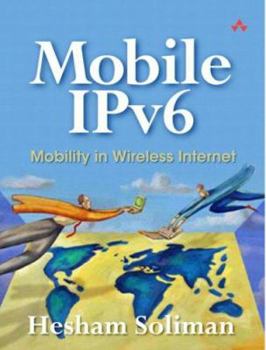Mobile IPv6: Mobility in a Wireless Internet
Select Format
Select Condition 
Book Overview
Explains MIPv6's structure, goals, deployment, operation, optimization, security, and more. This book reflects the IETF Mobile IPv6 standard, and provides an introduction to IPv6. It shows how MIPv6... This description may be from another edition of this product.
Format:Paperback
Language:English
ISBN:0201788977
ISBN13:9780201788976
Release Date:January 2004
Publisher:Addison-Wesley Professional
Length:338 Pages
Weight:1.50 lbs.
Dimensions:0.9" x 7.1" x 9.2"
Customer Reviews
2 ratings
Excellent resource on MobileIPv6
Published by Thriftbooks.com User , 17 years ago
This book provides an excellent discussion about MIPv6. It explains the MIPv6 protocol in detail. It also elaborates on the aspects of security and Handover. The book has a very helpful introduction about IPv6. The book does not include much about CDMA2000 based data networks, so for people looking for information about specific 3GPP2 extensions to MIPv6 this book might not be the best resource. My recommendation is that this book should be in the library of any engineer who works/intends to work with MIPv6.
Clear description of its subject
Published by Thriftbooks.com User , 20 years ago
The Internet currently uses IPv4, which has 32 bits of addressing. But over the next few years, this is expected to be exhausted, as China and other developing countries increasingly come online. Plus as your digital camera, car, cellphone and PDA are increasingly likely to have their own Internet addresses. Beyond IPv4 is IPv6, using 128 bits. So the question is not if IPv6 will be implemented, but when. Concomitant with this are questions about its viability, and, as a huge practical matter, how can it be incrementally deployed, side by side with existing IPv4 networks? Plus, how can mobile devices (think cellphones as the prime example) efficiently use IPv6? This is the subject of Soliman's book.The bulk of the book revolves around a problem which can best be described by a simple analogy. Suppose you have a cellphone with a phone number, which includes an area code. Nowadays, you can take that phone to any region in your country that supports cellphones, and expect your phone to work. Even if you are outside your area code. The phone companies have implemented algorithms that allow this.Mobility in IPv6 deals with the corresponding problem on the Internet. Imagine now that your cellphone or other device has a fixed IPv6 address. This is desirable so that others can contact you. Many issues now arise, along with possible solutions, as explained by Soliman. Like authentication and authorisation. That is, if you go to another IPv6 network and try to connect, it must somehow ascertain that you have a valid IPv6 address elsewhere.Or consider the very act of moving between two IPv6 networks, when you are communicating with someone else. How can that person's messages be forwarded to your new (temporary) IPv6 location, and how can it be done efficiently?The book describes these problems (and others) and their proposed solutions in detail. I say proposed solutions deliberately. As Soliman makes clear, some of these solutions will need further research as to their efficacies, and may well be modified as a result of this. You can get a clear sense of the subject and what the key issues are from this book.





